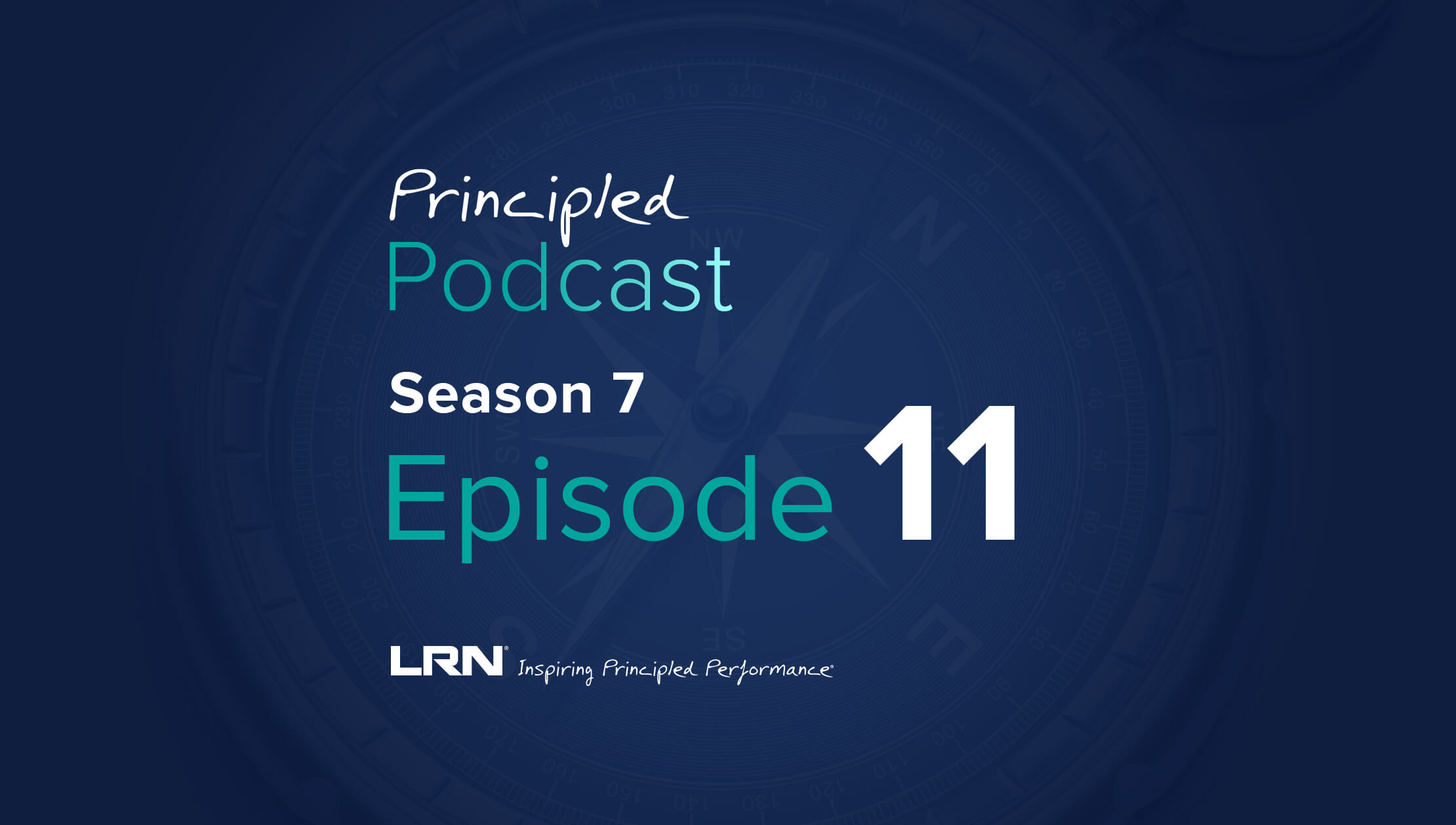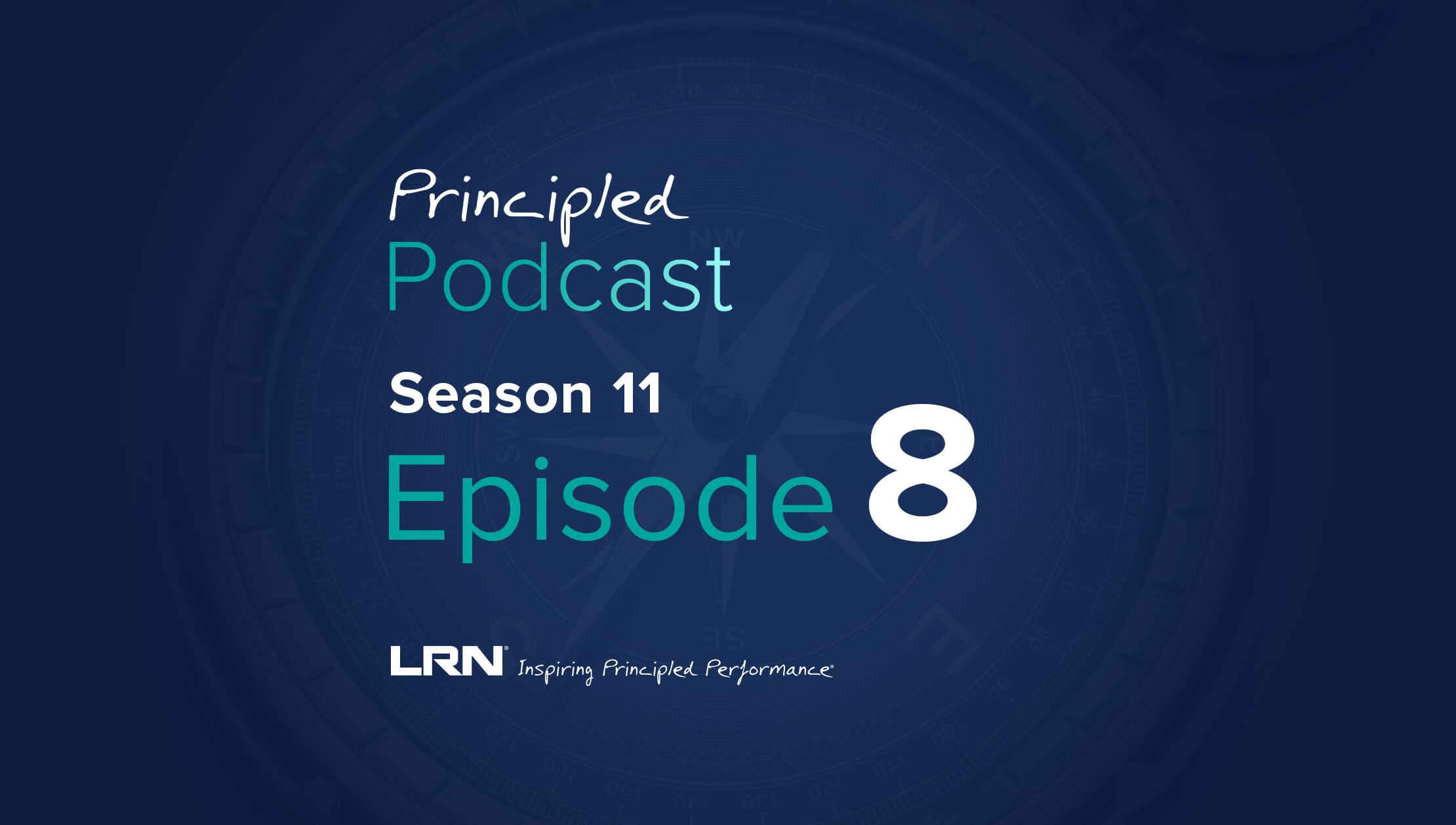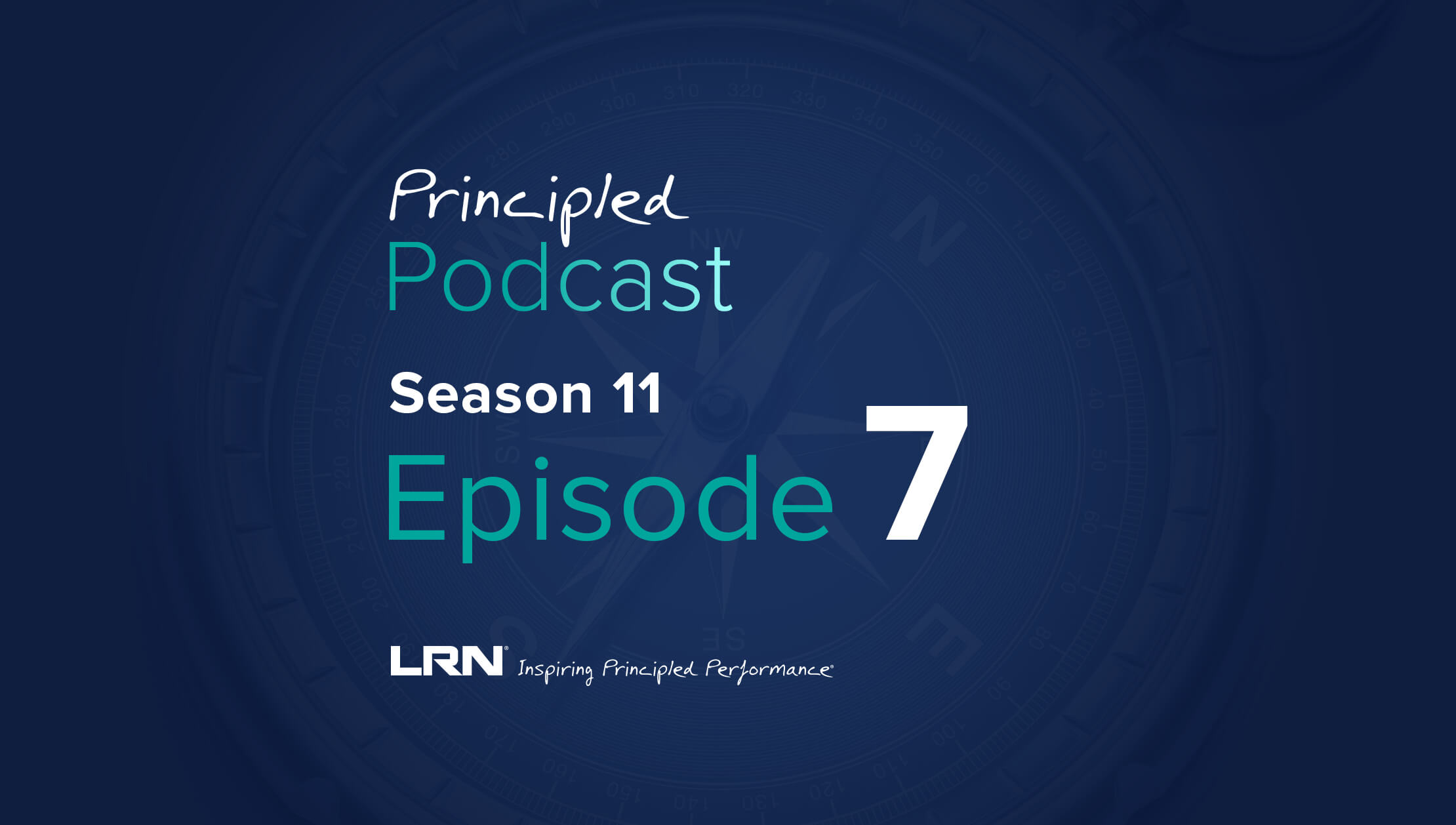What you'll learn on this podcast episode
A code of conduct is your organization’s character and culture written down. It articulates who you are, what you believe, and why you are in business. It also provides a reference for all stakeholders. A reference into what your organization values, and how you live those values. But how do you design and implement a code that communicates effectively? What does “good” look like when it comes to codes of conduct? In this episode of the Principled Podcast, host Jen Uner speaks with Senior E&C Advisor Jim Walton about LRN’s new Code of Conduct Report, which presents a set of best practices in code design and implementation. Listen in as the two unpack the report’s insights from nearly 150 codes of conduct deployed by companies around the world—including codes from 3M, General Motors, and Imperial Brands.
Where to stream
Be sure to subscribe to the Principled Podcast wherever you get your podcasts.
Guest: Jim Walton
Jim Walton is a member of LRN’s Ethics & Compliance Advisory Services Team – with over 25 years of professional experience in corporate, institutional and government settings, spanning the fields of ethics and compliance; environment, health and safety; and energy management.
Since 2002, Jim has been passionately dedicated to corporate ethics and compliance – designing, developing, implementing and enhancing constantly-evolving, comprehensive, best-in-class, global ethics and compliance programs. Jim has extensive experience in writing, producing and communicating codes of conduct and corporate policies; designing, managing and implementing ethics & compliance risk assessments; implementing anti-compliance and bribery initiatives; conducting third-party due diligence reviews; and helping managers at all levels become better ethical leaders.
Jim is a Certified Compliance and Ethics Professional.
Jen Uner is the Strategic Communications Director for LRN, where she captains programs for both internal and external audiences. She has an insatiable curiosity and an overdeveloped sense of right and wrong which she challenges each day through her study of ethics, compliance, and the value of values-based behavior in corporate governance. Prior to joining LRN, Jen led marketing communications for innovative technology companies operating in Europe and the US, and for media and marketplaces in California. She has won recognition for her work in brand development and experiential design, earned placements in leading news publications, and hosted a closing bell ceremony of the NASDAQ in honor of the California fashion industry as founder of the LA Fashion Awards. Jen holds a B.A. degree from Claremont McKenna College.
Principled Podcast transcription
Intro: Welcome to The Principle Podcast, brought to you by LRN. The Principle Podcast brings together the collective wisdom on ethics, business and compliance, transformative stories of leadership, and inspiring workplace culture. Listen in to discover valuable strategies from our community of business leaders and workplace change-makers.
Jen Uner: A code of conduct is your organization's character and culture written down. It articulates who you are, what you believe, and why you are in business. It also provides a reference for all stakeholders, a reference into what your organization values and how you live those values, and how you design and implement a code that communicates effectively. What does good look like when it comes to a code of conduct?
Hello, and welcome to another episode of LRN's Principle Podcast. I'm your host, Jen Uner, Strategic Communications Director at LRN. Today I'm joined by my colleague, Jim Walton, Senior Ethics and Compliance Advisor at LRN, and resident expert on codes of conduct.
We're going to be talking about LRN's new code of conduct excellence report, which is a work in process, and it presents a sort of best practices in code design and implementation. The report features insights from nearly 150 codes of conduct deployed by companies around the world.
Jim is a real expert in this space and has played a vital role in developing LRN's point of view, and our view that codes are foundational to developing and managing ethical corporate cultures. Jim, thanks for coming on the Principle Podcast.
Jim Walton: Thanks for having me, Jen.
Jen Uner: To start out, I want to validate that codes of conduct is something that people come to us on a regular basis for, right, help in crafting and re-imaging a code of conduct, and you're instrumental in that process. You're meeting with companies on a regular basis to re-invent, re-imagine and even start the process of developing a code of conduct.
Tell us first though why are codes so important? What do they accomplish for companies, and why is a good code of conduct something that really matters?
Jim Walton: Absolutely. As you said at the beginning, the code of conduct, and this is something we feel very strongly about at LRN, that a code should be an organization's character and culture written down. So when you look at a code of conduct you should get a sense of who that company is, what's important to them, what are their values, and how they do business, how they go about interacting with their colleagues, with their customers, suppliers, and the world around them.
The code of conduct is really the basic document that outlines that for all employees, so really helping to set the foundation for the ethical culture that everyone is trying to achieve.
We've seen an evolution of codes. In the past they were very rules-oriented, and now we're moving into much more of a principles and values-based code of conduct.
Jen Uner: Which is such a good idea I think as someone in communications. As a part of the process of creating the latest code of conduct excellence report you undertook with a team an assessment of codes by top firms, as I understand it, on four major stock exchanges. Tell us about this.
Jim Walton: We wanted to expand our reach beyond the United States, to cover some of the major markets where ethics and compliance programs should be fairly mature. We expected this to yield a good cross-section of codes of conduct for the study.
So we decided to pick the top 40 companies on the major stock exchanges in the following markets, the S&P in the US, the FTSE in the UK, the CAC in France, and the DAX in Germany. Out of a total of 160 companies we were able to find publicly available codes of conduct for 147 of them.
Jen Uner: That's pretty impressive. Just a quick sidebar, codes of conduct are typically available publicly? If only a handful were not available, would you say that most people are publishing publicly?
Jim Walton: Absolutely. And if you're publicly traded you really should have your code of conduct online. That would be a question that either the listing authority or the regulators who regulate securities in those jurisdictions might ask you about. Why is your code of conduct not publicly available?
Jen Uner: Yeah. Yeah. I could see that. So as you were looking at these codes of conduct, what exactly were you looking for in terms of assessment? What dimensions mattered the most in this process?
Jim Walton: We looked at what we called the eight dimensions of code effectiveness. These are tone from the top, purpose and value orientation, applicability and administration, speaking up, risk topics, knowledge reinforcement, usability, and look and feel.
They're all important in determining whether a code of conduct would be considered best in class or not, so it's really the combination of these dimensions and how they work together that can make or break a code of conduct.
If I had to pick the top three that are absolutely essential to get it right, I'd say purpose and values orientation, which is how closely and clearly the code is tied to the organization's primary purpose and shared values; risk topics, which is how does the code describe the specific behavioral expectations that make the values real and bring them to life on a daily basis; and usability.
It's critical for a code of conduct to be a useful resource that helps employees make ethical decisions, do the right thing, and find the information they're looking for when it comes to ethics and compliance.
Jen Uner: So it kind of sounds like there might be a weighting system going on as you assess these codes?
Jim Walton: Absolutely. Our assessment framework was originally developed in 2015 by former in-house ethics and compliance practitioners, drawing on research and experience on what makes an effective code. Over the past seven years we've continuously updated the assessment criteria to reflect the latest research, regulatory guidance and experience in helping organizations re-invent their codes of conduct.
Within each dimension there are a number of underlying criteria. Each will yield a score from one to five, with one being the worst and five being the best. As a result, we're able to produce an overall score for each code, as well as individual scores for each dimension.
Jen Uner: One of the things that I like about this analysis and this scoring as I was getting familiar with the report is that you didn't just divide the results into even thirds. You really applied kind of an indicator of excellence on each of the dimensions.
I think I saw that a minimum... Obviously with this process there's a minimum bar to hit to achieve a top rating, so the range, the way that I saw the data play out in what I was looking at, there were 17% that were ranked most effective, and the vast majority were effective, in the middle. I think it was like 50%, the remainder qualifying as less effective, which is how I would call excellent, serviceable, and needs work. What were the common markers of the most effective codes? How did these things shake out?
Jim Walton: First of all, I love your characterization of excellent, serviceable, and needs work, because that really describes it really well, about how, you know, it wasn't just looking at the top third, the middle third, and the bottom third.
We wanted to be fair. We'd love every code to have a score of five on every dimension, or at least a four across all dimensions, but that's just not realistic. So even with all of the progress that's been made with codes of conduct over the past five or ten years within the ethics and compliance space there's still a lot of work to do, and the bar just keeps being raised all the time.
So we decided that codes with an overall score higher than 3.5 would be categorized as more effective, or excellent, as you've said. Codes that score between 2.5 and 3.5, we consider those to be in the middle range, or effective, so it meets the basic needs. Nobody is going to get in trouble for missing something really important. Then finally the codes that are below 2.5 are considered less effective and need work, and sometimes a lot of work.
So the fact that exactly half of all the codes we evaluated fell in the middle, or effective or serviceable category, really indicates that many companies understand the need for a code, and they also understand the basic standards and expectations around codes.
On the other hand, the fact that one-third of the codes fell into the lowest category, and less than one-fifth were considered more effective in the top category, that suggests that there is significant room for improvement across the largest companies in France, Germany, the UK and the US.
Jen Uner: In taking a bit of a look at some of these results, was there anything that jumped out at you in terms of... You know, where is everybody tending to do well, like on which dimension, or which region is maybe out-performing the others?
Jim Walton: Yeah, that's a good question. The dimension that really scored the best overall was in tone from the top, so that's really good. That just tells me that... And that was about 50%. That tells me that people really get that. That's something that we've been hearing about for a long time now, and really having that strong support from the top is really essential. If you don't have that, then it's very difficult to create a strong culture of ethics and compliance.
The other area, and I was pleased to see this, was in terms of usability. Just about half or just under half landed in the top category for usability, so this is really encouraging, because I think it shows that there's a recognition that codes are supposed to be a useful resource and it's supposed to help guide employees in making ethical decisions, doing the right thing, and finding the information that they need.
On the other hand, the knowledge reinforcement was the dimension... Only 9% of the codes fell in the highest category for knowledge reinforcement, and this is a huge opportunity, because what we really want to do with a code of conduct is enhance the understanding of the concepts that are outlined in the code.
We do this through the use of real life scenarios as well as links to related policies, so people can get more detail on a specific topic area, linking it to training, videos, and other types of resources. So there's just a very big opportunity in that area and it's a really critical area.
Jen Uner: It sounds like to improve knowledge reinforcement, it's really about providing additional resources that support the code?
Jim Walton: Absolutely, and making them really... Really integrating them in the codes so people don't have to go anywhere else. If you're going about your job, you see something that doesn't look right, you say, "Oh, is that harassment or is that fraud? Let me go take a look at the code." You pull up the code, you quickly find the section that talks about that topic area. Maybe you need more information. You click on a link. You get a video that talks more about the topic, maybe additional training, and then in the end you're like, "Oh, I think we've got a problem. Let me click on the speak up link," and you can make a report or an inquiry about that topic area.
Jen Uner: Yeah. So accessibility is actually a really important piece of this?
Jim Walton: Absolutely, so making it available to people regardless of whether they have access to a laptop or a mobile phone, or in cases where you have offline employees, making the code available to them quickly in kiosks or terminals, or even giving people access to tablets and iPads and things like that.
Jen Uner: Yeah, my phone. The phone is a device that I walk around with all the time. It's my external brain. Put the code there.
Jim Walton: Absolutely.
Jen Uner: So I've got to ask, you were looking at publicly traded companies, right, publicly available codes? Which codes... If I wanted to go see an example of something good, who should I be looking at? What are some of the companies that landed at the top of the heap?
Jim Walton: Great question. Out of this group I'd say the best codes that we saw came from General Motors, Imperial Brands and 3M, so two from the S&P and one from the FTSE.
The first thing, you pull these codes up... And they're all available on the websites, the external websites of these companies. The first thing that makes these codes stand out is their visual appeal. They really reflect each of these companies' business brand, heritage, culture. You really get a sense of who they are. In the case of 3M and General Motors, and even Imperial Brands, you may be familiar with some of those brands, so the code would look very familiar.
Right up front they also talk about how the code helps the organization fulfill its purpose, so what's the reason why we get up in the morning and come to work, how do we enhance people lives, make the world a better place, and lining up with the core values of the company.
Then finally they're very readable and usable, so they're easy to navigate and move around in, find information, and the information is presented in a way that's understandable and digestible for the reader. They're really fantastic examples.
Jen Uner: That's great. I'm sure I'm going to be able to find those links and post them to the show notes for this podcast. So those are again large publicly traded companies. Let's say though I'm and entrepreneur or, better, I'm a venture capitalist, and I'm about to invest in a great kernel of a firm and help it scale up. I can see a big market opportunity for this new business venture. Let's just say I'm one of those VCs who truly understands the value of stakeholder capitalism and I've read the LRN benchmark of cultural report that tells me the most ethical companies outperform their peers by up to 40% across key business dimensions lik employee loyalty and and customer satisfaction and innovation and growth.
At what point do I, as a leader in a company like this, need to make sure my company is developing a strong code of conduct?
Jim Walton: That's a really good question, Jen. In working with dozens of companies to help them reinvent their codes of conduct over the years and in evaluating hundreds of codes along the way, we're finding that the size of the company does not always determine the maturity level of either their current code or their desire have a state-of-the-art code. We've seen large companies with really underwhelming codes and smaller ones with great ones.
But I will say for the situation you described, the place to really start is with the purpose and values. So really figure out what those are. Articulate them very clearly to everyone, because that's going to go a long way towards building the culture of ethics and compliance that everyone desires.
Once you've communicated those values and people really understand what they are and how to apply them, the next step would be to create a values based ethical decision making framework and add that to... Let's say this is a code, but the code is growing. So it may start out at a few pages, and then each iteration just gets a little bit longer. So the next thing is this framework to help people make those ethical decisions and make sure that it's based on the values.
At the same time, it's important to make sure that the code describes the speak up culture, in which people are encouraged to speak up and ask questions and raise concerns. This means making sure you've got all the right mechanisms in place to facilitate the speaking up, and also, importantly, equipping managers with the tools that they need to listen and to deal effectively with the concerns raised by their teams.
I think those are the places to start. Then you can add more detail to each of those areas and bring in more of the risk topics as you move forward.
Jen Uner: That makes sense. Start with the big picture and then get more and more granular. I think that makes total sense. Jim, it has been such a pleasure speaking with you today about great codes of conduct and the forthcoming report, the code of conduct excellence report. I'm looking forward to that release. I think we're slated for June with that, if I'm not mistaken?
Jim Walton: I think that's right.
Jen Uner: Yeah. And it's going to be available for free with registration at LRN.com. I also want to say as a part of this campaign I'm looking forward to listening to you actually host an episode of The Principle Podcast with one of our client partners, talking about code reinvention. I think that's going to be actually another really great episode on this topic.
Jim Walton: I'm looking forward to that as well.
Jen Uner: Jim Walton, thank you again for joining me on this episode of The Principle Podcast. My name is Jen Uner, and I wanted to thank you all for listening to The Principle Podcast by LRN.
Outro: We hope you enjoyed this episode. The Principle Podcast is brought to you by LRN. Out LRN our mission is to inspire principle performance in global organizations by helping them foster winning ethical cultures, rooted and sustainable values.
Please visit us at LRN.com to learn more, and if you enjoyed this episode subscribe to our podcast on Apple Podcasts, Stitcher, Google Podcasts, or wherever you listen, and don't forget to leave us a review.
Be sure to subscribe to the Principled Podcast wherever you get your podcasts.
















